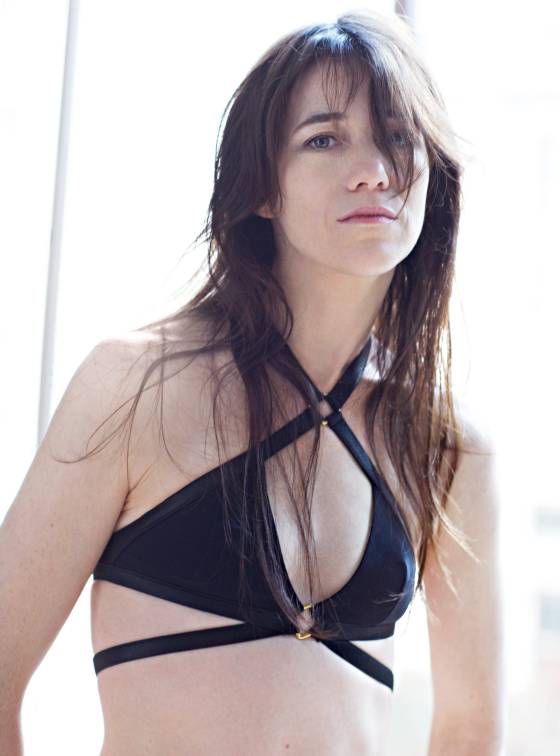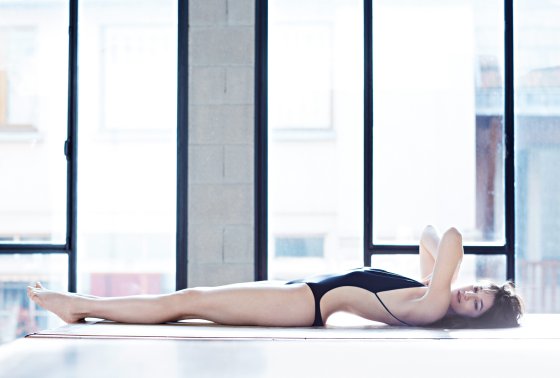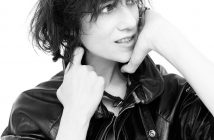By Carl Swanson, New York Magazine, March 2014

Photo: Dominique Issermann. Styling by Jonathan Huguet; Hair by Cyril Laloue at Julian Watson Agency; Makeup by Megumi Zlatoff at Calliste; Swimsuit by Agent Provocateur.
“Today? Today I am so-so,” says Charlotte Gainsbourg, nestled in the corner of the Ralph Lauren restaurant on Boulevard Saint-Germain, under a large painting of a seated dog. Gainsbourg is a pretty puddle of a woman, present and elsewhere at the same time. Her suede overcoat is in a pile next to her, and she’s drinking a café crème and ignoring the silver bowl of caramel popcorn while occasionally, and considerately, refilling my glass from a bottle of Evian. We’re here to discuss her role as Joe, the titular nymphomaniac in Lars von Trier’s two-part, determinedly dirty four-hour-plus sex epic in eight confessional chapters (interspersed with humanistic philosophizing). It’s like a porny, anxious Decameron à deux, in which Gainsbourg—as a character, yes, but also as an actress—is thoroughly, and voluntarily, abused, pleading repeatedly, “Fill all my holes.”
Nymphomaniac is her third time around with von Trier, and she says she’s “very sorry to say” that their collaboration “might be over,” though it becomes clear the worry might be just in her head. Over the restaurant’s tastefully muted Gershwin soundtrack, she tells me that she wasn’t able to go to the Berlin International Film Festival in February, where the completely uncensored, longer, and even more abject director’s cut of the film premiered. (And where her co-star Shia LaBeouf got in the acting-out act, showing up in a tux with a bag over his head, declaring himself no longer famous.) Von Trier, trying to persuade her to come to Berlin, told her, “That might be the last time we see each other.” Which she took possibly a little too much to heart, to mean that this would be her last film with him. “He is very mysterious,” she says. “He always gives little hints. And you have to catch and understand whatever you can. I wasn’t going to be very specific after that and ask him, ‘What does that mean? We’re not going to work together anymore?’ ” But she is visibly deflated at the prospect. After all, von Trier, the writer and director, gives her, the hungry actor, “things to eat,” she says.
But the reason for her so-so day has nothing to do with her relationship with a director who’s become something of a surrogate parent (withholding, semi-sadistic, but enthralling—she says he is “always right”), and everything to do with her real family. Earlier that day, she’d been “trying to put some order in my office and falling into a lot of things which had to do with my sister.” She’s referring to the photographer Kate Barry, her half-sister (they share a mother), with whom Gainsbourg was raised. Barry had fallen to her death out the window of her apartment in the 16th Arrondissement in December, apparently a suicide. “So it was quite emotional,” she says, enunciating carefully. “But it’s part of what I live now, the life I have now, without my sister. Sorry. It is very personal, but you ask, how was my day? And I couldn’t say perfect.”
She chose Ralph’s (“It’s so American,” she says, half-apologizing, with her gasping laugh) because it is close to the duplex she shares with the actor-director Yvan Attal and their three kids, who range in age from 2½ to 16. (The youngest is named Jo: “I chose Jo before Lars did. He wanted a boy’s name” for the nymphomaniac. “Our Jo doesn’t have an e. For the French, without an e, it’s more a boy’s name. The e is more feminine.”) And Ralph’s is only two blocks from the home of her late father, the louche and clever singer and mid-century French national treasure Serge Gainsbourg, on Rue de Verneuil, which she has kept, shrinelike, exactly as he left it when he died abruptly in 1991. (Except there’s a NO SMOKING sign on the front door today.) Her mother is Jane Birkin, the British singer-model-actress who sang the famously panting duet of romantic mixed signals with Serge, “Je t’aime … moi non plus,” which was such a sensation it was banned by radio stations in the U.K., Spain, and Italy. She also inspired that Hermès bag and lived until not so long ago a couple of blocks away, on Rue Jacob.
Gainsbourg was born in 1971 and has lived here, in the medieval center of Paris, and in the postwar center of the French pop consciousness, for most of her life. “I always want to move from here and try to find another place,” Gainsbourg says—perhaps in New York. “There’s a light there that is so beautiful which you can’t find here. The light can be quite depressing here. Nobody has filmed Paris in a very beautiful way the way New York is filmed. Godard was able to film it, of course, in a very beautiful way. In the ’60s, there was still some kind of magic,” she says.
She and Attal have been together for more than 20 years, but they aren’t married. “I’m superstitious,” she once said. “We’ve never married, and we’re happy. My parents weren’t married, so I don’t have an ideal image of marriage that I’m hoping for.” Her father was a self-created provocateur, painter, actor, director, and musician, the embodiment of French showmanship. Born Lucien Ginsburg, he was the son of a cabaret pianist who’d emigrated from Russia. Serge was the sort of drunk who called a press conference to announce he’d be upping his drinking and smoking after his first heart attack, even while going on TV as a caricature of himself he called “Gainsbarre.”
With the help of the architect Jean Nouvel, Charlotte tried for 15 years to turn Serge’s home into a museum. It is, after all, an accumulation of his life—framed gold records, toy monkeys, puppet dolls of himself, empty red jewelry boxes from Cartier, cameras, police badges from all over France, pictures of the women who sang his songs—Brigitte Bardot, Anna Karina, Petula Clark, Juliette Gréco, Catherine Deneuve, Isabelle Adjani, Marianne Faithfull, Françoise Hardy, Vanessa Paradis, and Birkin, with whom he stayed for 13 years. The outer walls of the house on the otherwise demurely picturesque block are to this day covered with layers of graffiti: LA POSTÉRITÉ L’AIME QUAND MÊME SERGE!, GAINSBOURG TOUJOURS!, etc., all accompanied by pasted-on drawings of his head, icons of cool.
These are the terms of her very French fame: Gainsbourg is the muse of Nicolas Ghesquière (who recently left Balenciaga for Louis Vuitton); her half-sister Lou Doillon is a model and actress; and Barry, a public advocate for recovery who battled addiction herself, had tried her hand at fashion design before turning to photography. Barry once said that taking up the camera was partly a defense: “I was photographed a lot as a kid. It must have made an impression on me … For a long time, my camera was a defense against the melancholy I felt.”
Gainsbourg, it seems, had an easier time of it, doted on (if that’s the word) by her father. It was always clear that she was going to go into the family business: acting, singing, modeling. “My mother knew I wanted to be an actress before I knew,” she says. “She understood it and could see it. I didn’t know what I wanted.” This was back in the early ’80s, when “I think she was shooting La Pirate,” about a lesbian trying to reconcile with her married ex, “and she said I looked like I was so envious of the little girl. There was a young girl of 14 in the film, and she could tell, when I was on set, that I was envious. I had that look of just wanting to be there.” In 2007, her proud mother told The Guardian: “Charlotte should be Katharine Hepburn, she has that elegance and funniness and a tragedy when her face is inert. She can make you cry without moving a muscle.”
Birkin and Serge Gainsbourg had split by the time Birkin encouraged Charlotte, then 13, to sing a duet with Dad called “Lemon Incest”—a pun, in French, on “lemon zest”—and also, perhaps more notoriously, to star in a video of it where he lounged shirtless, and very much 56, surrounded by smoke-machine effluvia, next to her, slightly stunned-looking but compliant, in little but a boy’s shirt—and looking rather like a boy (“The love that we will never make together / Is the most beautiful, the most violent …”).
Since then, she’s acted in both French films and English (most notably The Science of Sleep and Todd Haynes’s Bob Dylan movie, I’m Not There) and won awards (in 1986, she won a César Award for Most Promising Young Actress for L’Effrontée, and in 2009, Best Actress at Cannes for von Trier’s Antichrist). But she says she’s far from a “workaholic.” Twenty years passed between the album made with her father (Charlotte for Ever) and her next one, called 5:55, which came out in 2006.
 Photo: Dominique Issermann. Swimsuit by Thapelo Paris.
Photo: Dominique Issermann. Swimsuit by Thapelo Paris.
“I felt very much in my father’s hands when he did ‘Lemon Incest’ with me,” she says, echoing the way she speaks of giving herself over to von Trier’s narrative and directorial machinations. “I was never embarrassed by the song. Never, ever. I understood the lyrics. But that video—ack.”
In 2001, Attal, whom she’d met on a film set, made a cinematic love letter to her called My Wife Is an Actress. It’s about a sportswriter named Yvan who’s constantly being semi-humiliated by the fact that his wife, “Charlotte,” played by Gainsbourg, gets accosted on the streets of Paris but also gets him out of speeding tickets and into snooty restaurants (as well as clubs where he otherwise lacks “the look”), simply for being assuredly herself. This is played for laughs, though Yvan begins to lose it when he’s asked if it bothers him that “she sleeps with other men for a living.” “No, that’s a whore,” the character Yvan replies. Then he punches the man.
It’s an interesting film given Nymphomaniac, which features lots of whoring around, albeit with an adult-film actress doing what amounts to porn stunts. Von Trier’s Copenhagen-based film studio, Zentropa, also has made porn movies, both straight and gay, and, as with Antichrist, the director decided to include real sex. He allowed Gainsbourg, now 42, to choose her sex stunt double. “It was so embarrassing,” she says. The one she picked was German. “But because porn actresses have no hair down there, they had to put—too much hair I think. It was all fake hair. The guy who did the props, it was so funny: He had all these dicks and fake vaginas.” In the director’s cut, the physical consequences to Joe’s body are, she says, excruciating. “I’m very hurt in the end.”
But she seems to feel she gets von Trier, a notorious oddball who no longer talks to the press. (He was banned from Cannes in 2011 after making some sardonic comments about being able to “understand Hitler.”) And he her. “I wish he couldn’t shoot with any other actress,” she says. “I’ve always felt very close to him. He’s not a spectator.” In some ways, they seem to have complementary neuroses, or needy fragilities. “I’m very anxious, very unsure of myself,” says Gainsbourg. “Embarrassed, always embarrassed. I felt very, very normal facing him.” In fact, when they first met, for Antichrist, “I felt that he thought I was too normal. He called and said, ‘I want you in my film. But you have to agree to all of the nude scenes. There will be storyboards so you will know exactly what you have to do. So there are no surprises.’ I think the actress who was supposed to do the role—there was something which she didn’t want to do.”
But Gainsbourg was up for it—really up for anything. “For each film, there were really tough scenes he put me through. I mean, the death scene in Antichrist was really tough,” she says; for that, she was throttled around the neck by Willem Dafoe at von Trier’s direction. “He wanted to do it in one shot; it was so long and painful.” She’d just had surgery for a cerebral hemorrhage following a waterskiing incident, and “I thought my head was going to explode. It was terrible to do,” she says. (The hemorrhage meant getting lots of MRIs, the hums of which inspired her album IRM—MRI in French—which was produced by Beck and came out in 2009.) She also had to go and masturbate outside for the crew, her only direction from von Trier that she do it harder. And there were parts of von Trier’s Melancholia, a comparatively sedate film about the end of the world in which she played a comparatively sedate character, that she thought were “torture.” That said, “I never felt he was taking pleasure out of my suffering. He goes through those emotions with you. Or that’s what I felt. But at the same time I’m very masochistic.”
Even the trailers for Nymphomaniac were NSFW internet sensations. And while the uncensored version was edited down and softened for theatrical release—and split into two parts, to be released to theaters a month apart—the film is still an absurdist, push-your-buttons-you-bourgeois-hypocrite product by a director who has the letters FUCK tattooed on his knuckles. Its first life will be via on-demand video, which might be the movie’s natural, furtively avant-garde audience.
Each of the eight chapters is shot as its own film, in its own style. “I don’t have an explanation for why he is using black and white for this one and Godard’s light for this one, but it was very specific,” Gainsbourg says. “He had real principles for each chapter. In chapter one, he wouldn’t move the camera. And in another it was handheld. It was very established the way each one was going to be shot. But I don’t have an explanation. And I don’t really need any.”
One thing she’s not entirely happy with: the casting, as Joe’s younger self, of English actress Stacy Martin (Nymphomaniac is, for some reason, supposed to be set in the U.K., though like most of von Trier’s films it’s really set in a darkly enchanted fairyland of his own devising). “He did say when he gave me the script that I would not be playing myself young. But of course I wanted to play myself all the way through,” Gainsbourg says.
For someone who is so willing to be so thoroughly degraded—stripped naked, used, bruised, gangbanged, and nihilistically kicked to the curb, at least on film, but defiled and defiant to the end—Gainsbourg worries that people won’t still want her as an aging ingénue. So, as if in defense, she’s gotten busy: She’s done four films since September and has more to come this year (including Every Thing Will Be Fine, the Wim Wenders 3-D drama with James Franco). And she’s beginning a music project: She’s always been a mouthpiece for others’ music (from her father to the French group Air to Beck), but with her next project, “I’m trying to write it, if I can. I’m trying. I try to write the beginnings. I start off. I have ideas. But then I admired Beck much more than what I did myself. So it was very obvious to not go through the process by myself. But this time, I won’t work with Beck. I’m not sure who I will be working with. So I am trying to get as far as I can on my own.”
It’s all part of her effort to make herself more assertive, it seems. “In America,
I find that actresses can be producers and take control of themselves. Whereas when I started saying I really wanted to do that, I was not sure of who I was enough to say, ‘I am able to play this part and trust in me.’ I needed people to desire me.”
Then she thinks about that. “I say that I’m not a workaholic, but I understand that it’s been four years where I’ve been running from one project to another a bit helplessly. I can see that I am getting older and it does end. For women, it becomes harder, after 45 maybe. I hope 50.” “Embraceable You” is playing on the Ralph Lauren jazz-fantasy-of-Paris soundtrack. “It’s not that nice to see yourself aging. You can’t say that it’s something that’s very pleasurable.”
And then, digging into that shar-pei of a suede coat piled next to her, she notices a text. “Oh! It’s Lars! He is saying he had a great time in Berlin.” She smiles, delighted, relieved. “Oh, I love him.”
*This article appeared in the March 10, 2014 issue of New York Magazine.



